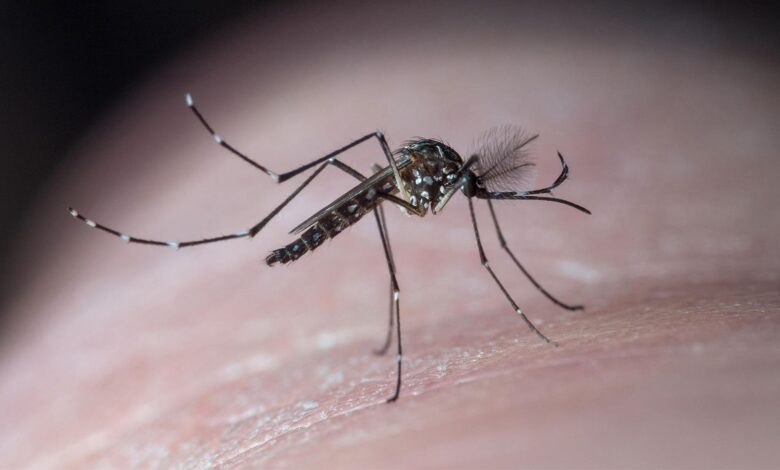West Nile and EEE: What to Know About Mosquito-Borne Illness in the U.S.

Two mosquito-borne viruses are making headlines this week: West Nile virus for hospitalizing Anthony Fauci, MD, and eastern equine encephalitis (EEE) virus for prompting curfews in some Massachusetts towns.
While both are transmitted through the bite of an infected mosquito, and both can lead to severe brain swelling, that’s largely where the similarities end.
Here’s what you need to know about each virus — and about other mosquito-borne illnesses that sometimes cause a buzz in the U.S.
West Nile Virus
Ian Lipkin, MD, of Columbia University in New York City, first identified West Nile virus as the cause of an outbreak of encephalitis in New York in 1999.
By using a broader sequencing method than what was generally available at the time, Lipkin matched sequences from human brain tissue to those in a database and was able to narrow it down to a “West Nile-like” virus. The virus had been isolated in Uganda in 1937, and had caused outbreaks in Europe, Africa, the Middle East, and parts of Asia before being brought into the U.S.
“We now know it truly was West Nile virus,” Lipkin told MedPage Today. “No one really knows for sure how it got here, but there have been suggestions that there might have been a transfer by mosquitoes from the Middle East.”
There’s particular suspicion that geese imported for foie gras that came through LaGuardia Airport in Queens, New York, may be to blame, Lipkin said, as the first cases started popping up in the summer of 1999 around that airport.
Since that time, West Nile has become endemic in the U.S., peaking at around 10,000 cases in 2003, then averaging about 2,000 cases per year, according to CDC data. So far in 2024, there have been 289 cases of the disease identified in 33 states.
In about 80% of cases, West Nile is completely asymptomatic. For the 20% who become symptomatic, a smaller subset have severe illness including encephalitis, and overall only 1% of people die from the virus, according to Amesh Adalja, MD, of Johns Hopkins University in Baltimore.
“For the vast majority of people who get it, they may not even know that they were sick,” Adalja told MedPage Today.
Severe illness due to infection with the virus is most likely to strike older or immunocompromised people, and symptoms can include fever, chills, and headache. Fauci told STAT of his bout with West Nile, stating that he’s “never been as sick in my life,” as he experienced extreme fatigue, “profound” weakness, hours of “shaking chills” over several nights, and a fever that spiked at 103°F.
West Nile virus is part of the genus Flavivirus, which also includes other viruses that typically infect humans through the bite of an infected mosquito including dengue, yellow fever, and Zika, Adalja said.
Birds are the main viral reservoir, particularly corvids (ravens, magpies, crows, and others), Lipkin said. He recalled dramatic scenes from when the virus first hit U.S. shores: “This really captured the imagination of people at the time because there were hundreds of thousands of birds dying across the U.S. It was striking. You’d walk out and see hundreds of birds dead on the ground.”
Mosquitoes that feed on the birds can then transfer the virus to humans, and there are several types of mosquitoes that can carry the virus, including Culex and Culiseta mosquitoes. (Both are generally found in northern U.S. and southern Canada.)
There’s currently no vaccine and no treatment specific to West Nile virus. As with any mosquito-borne illness, the best way to prevent it is to avoid being bitten by the critters.
Lipkin said a simple electric fan can be an easy way to block bites. “Mosquitoes are not very strong fliers,” he said. “If you have a fan blowing at you, it’s going to be hard for a mosquito to land on you.”
Triple E Virus
EEE is a more aggressive disease, Adalja said, although it’s much less frequent, with just four cases reported in the U.S. this year (likely now five cases given a recently reported death in New Hampshire).
“EEE is a more dangerous virus, but the impact of West Nile is bigger because it’s more widespread,” Adalja said. While the majority of EEE cases are found in the Northeast and Gulf Coast states, a case was detected in Wisconsin this year, he noted.
It’s generally “really rare,” he said, averaging somewhere between 12 and 15 cases a year. Yet “about 30% of people who get it die, and those who do survive are often left with severe disability.”
Philip Chan, MD, of Brown University in Providence, Rhode Island, has treated some cases of EEE in his 7 years at the hospital. While severe disease from EEE is most common in older and immunocompromised people, it can hit just about anyone, he said.
He recalled a young person who had been athletic and healthy who developed a bad infection from the virus. This person “luckily survived but was in the ICU for a couple weeks,” Chan said. “So caution is warranted, regardless of age.”
Shira Doron, MD, of Tufts Medicine in Boston, noted that EEE outbreaks have about a 10-year cadence and last about 2 to 3 years. The last outbreak in Massachusetts brought 12 cases and six fatalities in 2019 and five cases with one fatality in 2020, she said.
“It’s a very serious disease, but one has to remember a 50% case fatality rate is not a 50% infection fatality rate,” Doron told MedPage Today. “There are going to be a ton of infections going undetected.”
Adalja agreed that “there is probably a denominator problem, but it’s safe to say that when EEE cases come to light, they are very severe. Whereas with West Nile, you find antibodies in the blood supply. It’s much more widespread and clearly there’s a big difference in epidemiology in humans between the two.”
Doron emphasized that “we’re not seeing anything unusual” in Massachusetts as far as EEE goes this year, despite some towns there receiving substantial media attention for implementing voluntary curfews for some public spaces to curb the spread of EEE.
EEE is part of the genus Alphavirus, which also includes Chikungunya, Western EE, and Venezuelan EE viruses. Horses and birds are the main viral reservoirs.
Chan said the symptoms are similar to West Nile, particularly when it comes to severe disease and encephalitis. “The classic symptoms tend to be fever, headache, and mental status changes,” he said. There’s no vaccine or treatment, so patients usually receive supportive care.
Other Mosquito-Borne Illness in the U.S.
There have been other brushes with mosquito-borne disease, including dengue virus, Zika virus, Chikungunya virus, and malaria.
Puerto Rico has been experiencing an ongoing outbreak of dengue, with more than 2,500 cases reported this year, according to the CDC. More than 3,800 cases were reported in the U.S. this year, but few of those were due to local transmission, and all of those cases occurred in Florida.
The CDC even issued a Health Alert Network (HAN) advisory in June about an increased risk of dengue infections, urging healthcare providers to suspect the virus in people who traveled to areas where viral transmission is high.
Lipkin said the mosquitoes capable of carrying dengue are “moving further north” due to climate change, and expressed concern that dengue may pose a more regular threat in the U.S. mainland.
As for Chikungunya, there were 12 cases of locally acquired infection in the U.S. mainland in 2014, ending with just one such case the following year, according to the CDC. And for Zika, there were 224 locally acquired infections in the U.S. mainland in 2016, followed by seven the next year, and falling off after that.
Last year, the CDC issued a HAN advisory on local transmission of malaria in Florida and Texas, the first such cases in 20 years.
Doron said epidemiologists have raised concerns that patterns of mosquito-borne infections will change as the climate warms. “We can mitigate some of that with larvicide and insecticide, but there are downsides to that,” she added.
Adalja thinks it may be time to bring in the bigger guns. “We’ve made advances with genetically modified mosquitoes and sterile male mosquitoes,” which he acknowledges has caused some controversy among people opposed to genetic modification. “I think it’s high time people start … deploying these in the U.S.”
-
![author['full_name']](https://clf1.medpagetoday.com/media/images/author/kristinaFiore_188.jpg)
Kristina Fiore leads MedPage’s enterprise & investigative reporting team. She’s been a medical journalist for more than a decade and her work has been recognized by Barlett & Steele, AHCJ, SABEW, and others. Send story tips to k.fiore@medpagetoday.com. Follow


